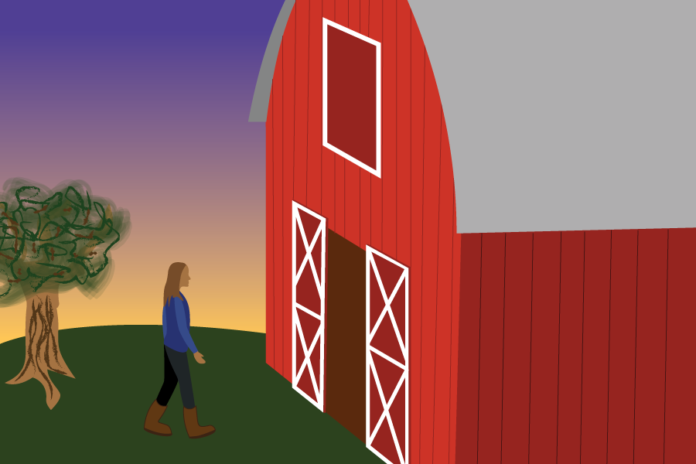ANS 49C gives students the opportunity to apply their knowledge to hands-on work with dairy cattle
While the majority of students are likely sleeping soundly in their beds at 5 a.m., third-year animal science major Nicole Elmer is already awake and beginning her three-hour lab session at the UC Davis dairy. When she was enrolled in the two-unit Animal Management Practices in Dairy course (ANS 49C) last quarter, Elmer worked with the dairy cows on campus to learn the processes for safe and healthy milk production in the early hours of the morning.
Although students take the class to enrich their knowledge, the animals’ welfare is always prioritized, which is why the lab is at 5 a.m. The dairy cows need twelve hours in between milkings, which are scheduled at 4 p.m. and 4 a.m. The ANS 49C students work one-on-one with a full-time milker at the Dairy, who typically comes in an hour before the students to get started on the milking process.
ANS 49C is part of a series of ANS 49 courses through the Department of Animal Science, offering students hands-on experience at each of the animal barns on campus while under the careful guidance of animal facility managers. Currently, there are ten courses offered including management of goats, horses, swine and companion avian species.
The series is not a requirement for the major, but since many animal science majors come in without much hands-on experience with different types of animals, the 49 series is integral in specifying one’s field of interest for their future career. For Elmer, the class enabled her to take her interests in the classroom and explore them in real life, affirming her decision to specialize in livestock and dairy.
“I had taken an animal physiology class in high school, and we learned a bunch of stuff about cows, and I think we dissected like an eye or something, and I thought, ‘This is amazing,’” Elmer said. “I wanted to see if I actually like them in life or if I like them on paper, and that class is really helpful in solidifying the fact that yes, I do like cows, I’m comfortable around them and I like working with them.”
Dr. Edward DePeters, a distinguished professor and master advisor in the Department of Animal Science, said the courses also teach students the “how” and the “why” behind the science they learn in lectures.
“How to do things is important — and for the urban students, learning how to milk a cow is a great experience,” DePeters said. “But, the ‘why’ is just as important. Why do we do the various management practices to ensure proper animal care and welfare and to ensure safe and wholesome milk and meat? An instructor may talk about milking cows and goats in lecture, […] but that is different than actually milking a cow yourself, doing the udder preparation for milking, applying the milking unit and then doing the post-milking procedures.”
ANS 49C also has a 50-minute discussion section for students to learn more about the Dairy’s operations in a more traditional classroom setting. It covers both management and milking related topics such as preventing mastitis, an inflammation of the udder tissue, and efficiently setting a milking schedule. A dairy industry professional leads the discussion section, which Elmer said helped her learn what a future client looks for in a veterinarian.
“He would tell us what he looks for in a vet and like skills that we should have, [such as] ‘Oh, you should know about nutrition so when I ask you a question you don’t just have to go look it up, because there are certain things that you should just kind of know,’” Elmer said. “That was really cool to learn from somebody because you learn all of this stuff in class and you’re just like when am I ever going to use all the stuff that I learned, and he’s just like ‘Oh, you actually use all of those right here.’”
For Elmer, the fact that the lab was at 5 a.m. was inconsequential. In fact, she said she looked forward to seeing the cows early in the morning.
“You kind of get to know the cows and form a little bond with them, like I had this favorite Jersey cow, 883, and I would get excited everytime I would get to milk her like, ‘Oh, it’s my buddy!’” Elmer said. “I think that was just the coolest part, seeing the progression of, ‘Oh I’m comfortable around these cows and they’re comfortable around me ‘cause we’ve been together three hours a week for ten weeks.’”
The ANS 49 courses are open to any undergraduate student, no matter their major. Professor DePeters encourages non-majors to try out a course, especially because there are no prerequisites.
“I always say that the prerequisite is that you gotta have a pulse.” DePeters said. “You gotta go to the lab, and you gotta go to the discussion. And if you do that, and you write a simple paper, you’re gonna pass the class because it’s a pass/no pass class — it’s not letter graded. So if you have a P as in ‘pulse ’ — you do your stuff, you go to class — you’ll get a pass. If you have no pulse, that’s NP — you don’t go to class, you won’t pass.”
And if students are intimidated by the 5 a.m. lab section, fear not — a 4 p.m. milking lab is offered as well.
Written by: Lei Otsuka — features@theaggie.org



